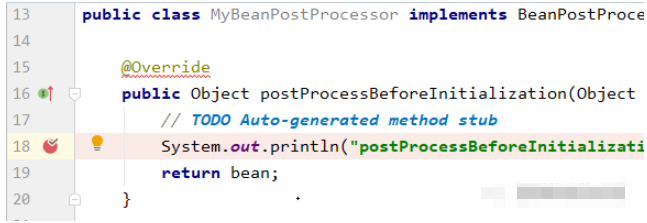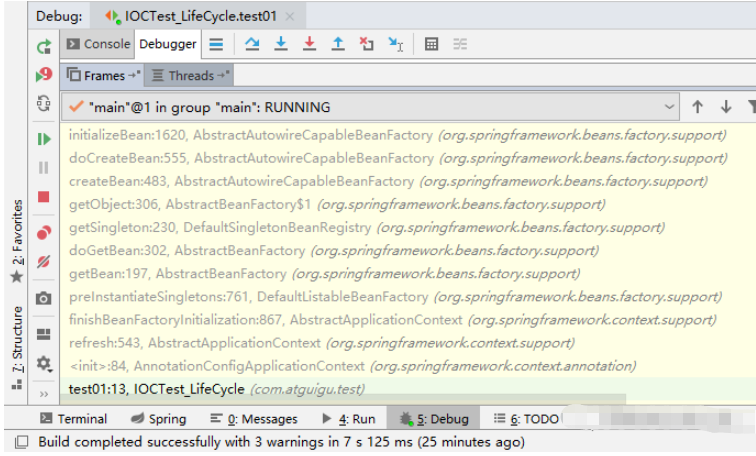这篇文章主要介绍了BeanPostProcessor怎么在spring中的应用的相关知识,内容详细易懂,操作简单快捷,具有一定借鉴价值,相信大家阅读完这篇BeanPostProcessor怎么在spring中的应用文章都会有所收获,下面我们一起来看看吧。
1.BeanPostProcessor 执行原理


public AnnotationConfigApplicationContext(Class<?>... annotatedClasses) { this(); register(annotatedClasses); refresh(); }// Instantiate all remaining (non-lazy-init) singletons. finishBeanFactoryInitialization(beanFactory);// Instantiate all remaining (non-lazy-init) singletons. beanFactory.preInstantiateSingletons();getBean(beanName);// Create bean instance. if (mbd.isSingleton()) { sharedInstance = getSingleton(beanName, new ObjectFactory<Object>() { @Override public Object getObject() throws BeansException { try { return createBean(beanName, mbd, args); } catch (BeansException ex) { // Explicitly remove instance from singleton cache: It might have been put there // eagerly by the creation process, to allow for circular reference resolution. // Also remove any beans that received a temporary reference to the bean. destroySingleton(beanName); throw ex; } } }); bean = getObjectForBeanInstance(sharedInstance, name, beanName, mbd); }Object beanInstance = doCreateBean(beanName, mbdToUse, args);Object exposedObject = bean; try { populateBean(beanName, mbd, instanceWrapper); if (exposedObject != null) { exposedObject = initializeBean(beanName, exposedObject, mbd); } }Object wrappedBean = bean; if (mbd == null || !mbd.isSynthetic()) { wrappedBean = applyBeanPostProcessorsBeforeInitialization(wrappedBean, beanName); } try { invokeInitMethods(beanName, wrappedBean, mbd); } catch (Throwable ex) { throw new BeanCreationException( (mbd != null ? mbd.getResourceDescription() : null), beanName, "Invocation of init method failed", ex); } if (mbd == null || !mbd.isSynthetic()) { wrappedBean = applyBeanPostProcessorsAfterInitialization(wrappedBean, beanName); }@Override public Object applyBeanPostProcessorsBeforeInitialization(Object existingBean, String beanName) throws BeansException { Object result = existingBean; for (BeanPostProcessor beanProcessor : getBeanPostProcessors()) { result = beanProcessor.postProcessBeforeInitialization(result, beanName); if (result == null) { return result; } } return result; }populateBean() 函数进行填充,invokeInitMethods(beanName, wrappedBean, mbd);函数进行初始化,然后前后有applyBeanPostProcessorsBeforeInitialization 和applyBeanPostProcessorsAfterInitialization 进行对所有的BeanPostProcessor 扫描执行。
2.BeanPostProcessor 在spring 中的应用
@Componentpublic class Dog implements ApplicationContextAware { private ApplicationContext applicationContext; public Dog(){ System.out.println("dog constructor..."); } @Override public void setApplicationContext(ApplicationContext applicationContext) throws BeansException { // TODO Auto-generated method stub this.applicationContext = applicationContext; }}2.通过invokeAwareInterfaces判断Bean 的类型进行类型转换,并进行赋值
private void invokeAwareInterfaces(Object bean) { if (bean instanceof Aware) { if (bean instanceof EnvironmentAware) { ((EnvironmentAware) bean).setEnvironment(this.applicationContext.getEnvironment()); } if (bean instanceof EmbeddedValueResolverAware) { ((EmbeddedValueResolverAware) bean).setEmbeddedValueResolver(this.embeddedValueResolver); } if (bean instanceof ResourceLoaderAware) { ((ResourceLoaderAware) bean).setResourceLoader(this.applicationContext); } if (bean instanceof ApplicationEventPublisherAware) { ((ApplicationEventPublisherAware) bean).setApplicationEventPublisher(this.applicationContext); } if (bean instanceof MessageSourceAware) { ((MessageSourceAware) bean).setMessageSource(this.applicationContext); } if (bean instanceof ApplicationContextAware) { ((ApplicationContextAware) bean).setApplicationContext(this.applicationContext); } } }@Override public Object postProcessBeforeInitialization(Object bean, String beanName) throws BeansException { LifecycleMetadata metadata = findLifecycleMetadata(bean.getClass()); try { metadata.invokeInitMethods(bean, beanName); } catch (InvocationTargetException ex) { throw new BeanCreationException(beanName, "Invocation of init method failed", ex.getTargetException()); } catch (Throwable ex) { throw new BeanCreationException(beanName, "Failed to invoke init method", ex); } return bean; }public void invokeInitMethods(Object target, String beanName) throws Throwable { Collection<LifecycleElement> initMethodsToIterate = (this.checkedInitMethods != null ? this.checkedInitMethods : this.initMethods); if (!initMethodsToIterate.isEmpty()) { boolean debug = logger.isDebugEnabled(); for (LifecycleElement element : initMethodsToIterate) { if (debug) { logger.debug("Invoking init method on bean '" + beanName + "': " + element.getMethod()); } element.invoke(target); } }}@Override public Object postProcessBeforeInitialization(Object bean, String beanName) throws BeansException { if (!this.afterInitialization) { doValidate(bean); } return bean; } @Override public Object postProcessAfterInitialization(Object bean, String beanName) throws BeansException { if (this.afterInitialization) { doValidate(bean); } return bean; }关于“BeanPostProcessor怎么在spring中的应用”这篇文章的内容就介绍到这里,感谢各位的阅读!相信大家对“BeanPostProcessor怎么在spring中的应用”知识都有一定的了解,大家如果还想学习更多知识,欢迎关注亿速云行业资讯频道。
亿速云「云服务器」,即开即用、新一代英特尔至强铂金CPU、三副本存储NVMe SSD云盘,价格低至29元/月。点击查看>>
免责声明:本站发布的内容(图片、视频和文字)以原创、转载和分享为主,文章观点不代表本网站立场,如果涉及侵权请联系站长邮箱:is@yisu.com进行举报,并提供相关证据,一经查实,将立刻删除涉嫌侵权内容。
原文链接:https://my.oschina.net/u/4134523/blog/4726816